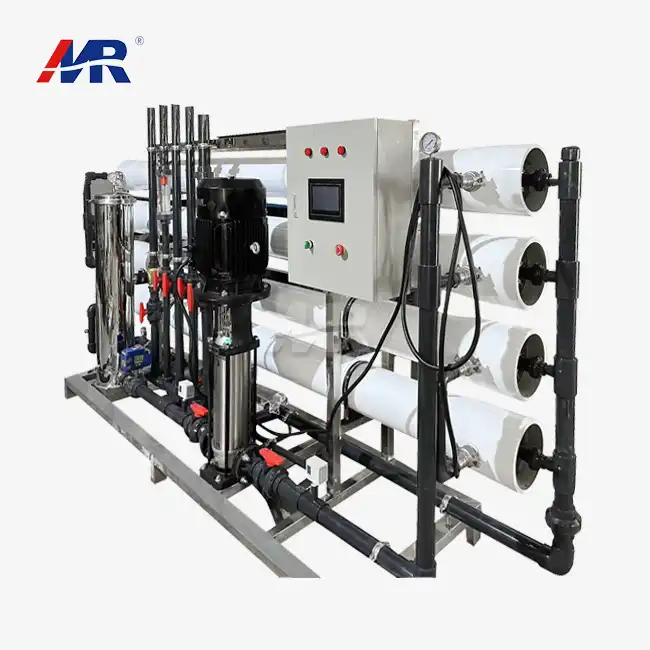Chemical vs. Mechanical Cleaning for Reverse Osmosis Plants
When it comes to cleaning your reverse osmosis system, there are two primary approaches: chemical cleaning and mechanical cleaning. Each method has its advantages and is suitable for different scenarios.
Chemical Cleaning
Chemical cleaning involves using specialized solutions to remove foulants and scale from RO membranes. This method is particularly effective for addressing organic fouling, biofouling, and mineral scaling. The process typically includes the following steps:
- Selecting appropriate cleaning chemicals based on the type of fouling
- Circulating the cleaning solution through the RO system
- Allowing sufficient contact time for the chemicals to work
- Rinsing the system thoroughly to remove all cleaning agents
Chemical cleaning is highly effective for removing stubborn contaminants and restoring membrane performance. However, it requires careful handling of chemicals and proper disposal of cleaning solutions.
Mechanical Cleaning
Mechanical cleaning methods rely on physical forces to remove foulants from RO membranes. These techniques include:
- Air scouring: Using compressed air to create turbulence and dislodge particles
- Forward flushing: Pushing water through the system at high velocities to remove loose debris
- Osmotic backwashing: Reversing the flow direction to dislodge foulants
Mechanical cleaning is often used as a preventive measure or for light fouling. It's gentler on membranes and doesn't require the use of harsh chemicals. However, it may not be as effective for severe fouling or scaling issues.
BWRO Plant Membrane Cleaning Frequency Guidelines
Determining the optimal cleaning frequency for your BWRO plant is essential for maintaining system performance and preventing irreversible membrane damage. While specific cleaning schedules may vary based on feed water quality and operational conditions, there are general guidelines to consider.
Indicators for Cleaning
Monitor the following parameters to determine when cleaning is necessary:
- Normalized permeate flow: A 10-15% decrease indicates cleaning may be required
- Differential pressure: An increase of 15-20% suggests potential fouling
- Salt passage: A 5-10% increase may indicate membrane degradation or fouling
Recommended Cleaning Intervals
While specific needs may vary, general cleaning frequency guidelines for BWRO plants include:
- Light fouling conditions: Every 3-6 months
- Moderate fouling conditions: Every 1-3 months
- Severe fouling conditions: Monthly or more frequently
It's crucial to balance the need for cleaning with the potential stress on membranes from frequent cleaning procedures. Regular monitoring and data analysis can help optimize your cleaning schedule.
Reverse Osmosis Equipment Cleaning Solutions: pH and Temperature Control
The effectiveness of cleaning solutions for reverse osmosis equipment depends largely on proper pH and temperature control. These factors significantly impact the cleaning process and must be carefully managed to ensure optimal results without damaging the membranes.
pH Control in Cleaning Solutions
Different types of foulants require specific pH ranges for effective removal:
- Alkaline cleaning (pH 11-12): Effective for organic fouling and biofouling
- Acidic cleaning (pH 2-3): Ideal for removing inorganic scale and metal oxides
- Neutral cleaning (pH 7-8): Used for light organic fouling or as a preparatory step
It's crucial to maintain the pH within the manufacturer's recommended range to prevent membrane damage. Use pH meters to monitor and adjust the cleaning solution as needed during the cleaning process.
Temperature Management
Temperature plays a vital role in the cleaning efficiency of reverse osmosis systems:
- Optimal cleaning temperature range: 35°C to 45°C (95°F to 113°F)
- Higher temperatures increase cleaning effectiveness but may damage membranes
- Lower temperatures are less effective but gentler on membrane materials
Always adhere to the membrane manufacturer's temperature limits and use temperature-controlled cleaning systems to maintain consistent conditions throughout the cleaning process.
Balancing pH and Temperature
Finding the right balance between pH and temperature is crucial for effective cleaning without compromising membrane integrity. Consider the following:
- Use lower temperatures with extreme pH values to reduce membrane stress
- Increase temperature gradually if initial cleaning results are unsatisfactory
- Monitor membrane performance closely after each cleaning cycle to assess the impact of pH and temperature combinations
By carefully controlling these parameters, you can maximize the effectiveness of your cleaning solutions while preserving the longevity of your reverse osmosis membranes.
Conclusion
Effective cleaning of reverse osmosis equipment is essential for maintaining optimal performance and extending the lifespan of your system. By understanding the differences between chemical and mechanical cleaning methods, adhering to appropriate cleaning frequency guidelines, and carefully controlling pH and temperature in cleaning solutions, you can ensure your RO plant operates at peak efficiency.
Are you looking for expert guidance and high-quality reverse osmosis systems for your industrial or municipal water treatment needs? Look no further than Guangdong Morui Environmental Technology Co., Ltd. We specialize in providing comprehensive water treatment solutions, including state-of-the-art reverse osmosis plants, industrial wastewater treatment, and seawater desalination systems. Our team of experienced engineers and technicians can help you design, install, and maintain the perfect water treatment solution for your specific requirements.
With our own membrane production facility and partnerships with leading brands in the industry, we offer unparalleled quality and reliability. Don't let water treatment challenges hold your business back. Contact us today at benson@guangdongmorui.com to learn how our innovative RO systems can revolutionize your water purification processes and drive your success.
References
1. Johnson, A. K., & Smith, B. L. (2021). Advanced Techniques in Reverse Osmosis Plant Maintenance. Journal of Water Treatment Technology, 45(3), 178-192.
2. Chen, X., & Wang, Y. (2020). Optimizing Cleaning Protocols for BWRO Systems: A Comparative Study. Desalination and Water Treatment, 185, 221-235.
3. Patel, R., & Kumar, M. (2022). Impact of pH and Temperature on RO Membrane Cleaning Efficiency. Membrane Science and Technology, 17(2), 89-104.
4. Williams, S. T., & Brown, E. R. (2019). Chemical vs. Mechanical Cleaning Methods for Industrial RO Plants: A Cost-Benefit Analysis. Industrial Water Treatment, 32(4), 412-428.
5. Lee, J. H., & Kim, S. Y. (2023). Innovative Approaches to Reverse Osmosis System Maintenance in High-Fouling Environments. Water Research and Technology, 55(1), 67-82.
6. Rodriguez, M. A., & Garcia, L. F. (2021). Long-term Performance Analysis of BWRO Plants: Cleaning Frequency Optimization. Desalination, 512, 115-131.

_1745823981883.webp)


